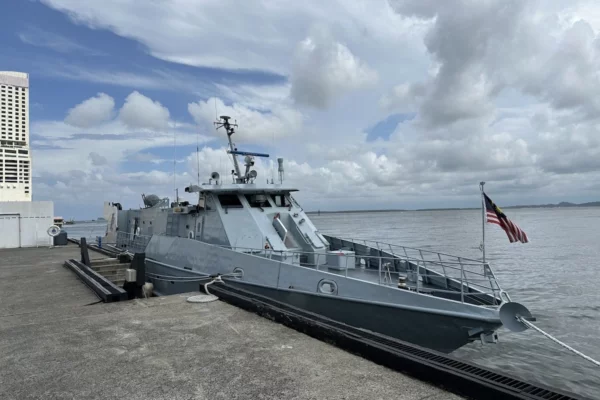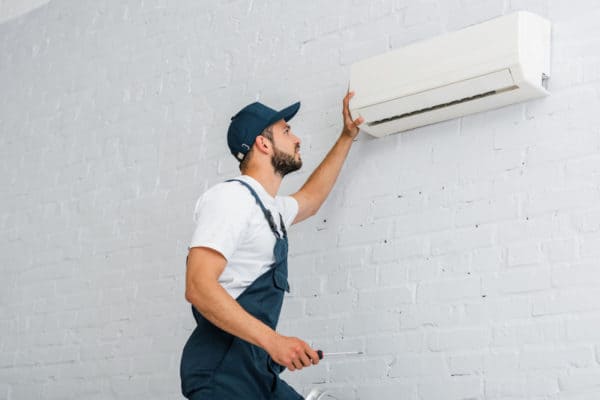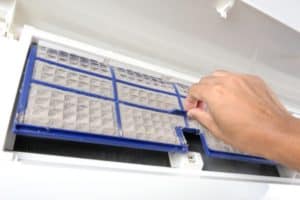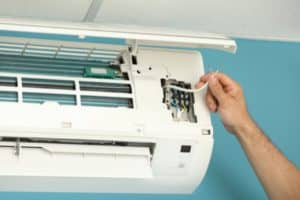How Air Conditioning Works in Aircraft?
I’ve always wondered how air conditioning works in aircraft. Certainly, the working environment of the air conditioner on an airplane is different from the air conditioner found in buildings. So, I did some research.
It turns out that air conditioning in aircraft works by taking a small amount of sterilized air from the jet engine and compressing it. Then, the air is cooled by the ambient air via a heat exchanger. Next, the cooled air is expanded by an expansion turbine, causing its temperature to drop further. Finally, water vapor in the cold air is extracted before the cold air is sent to the aircraft cabin.
The air conditioning system in aircraft works very differently from the air conditioning system found in residential and commercial buildings. It is quite interesting. So, let’s take a closer look.
How Aircraft Air Conditioning System Works?
The air conditioning system in modern aircraft is quite different from the one in older aircraft. Modern aircraft have a more efficient air conditioning system. Nonetheless, refrigerant is not used as the heat transfer medium in aircraft air conditioning systems.
Components
To understand the air conditioning system in aircraft works, we need to briefly understand a few components of the aircraft:
- Jet Engine: Takes in low-pressure air, compresses it into high pressure and rejects it to provide thrust.
- Air-to-Air Heat Exchanger: Enable heat transfer between two different-condition air.
- Turbine Compressor: Basically a centrifugal compressor that compresses the air.
- Expansion Turbine: A turbine that expands the air.
- Air Cycle Machine (ACM): A name for the combination of the turbine compressor and the expansion turbine. Both turbines are interconnected.
- Water Separator: Basically a dehumidifier that extracts moisture from the air to prevent freezing.
- Aircraft Cabin: The place where passengers, crews and pilots be at.
At the heart of the aircraft air conditioning system is the air cycle machine (ACM). ACM is a term used by the aviation industry. On top of that is the ECS or environmental control system that governs the control system of aircraft including the air conditioning system.
Supply Air System
The air conditioning system in aircraft starts from the jet engine. A small amount of pressurized hot air is taken into the air conditioning system. The pressure and temperature of the air are controlled at about 32 psi (220 kPa) and 165°C (330°F) respectively.
Such air is known as the bleed air.
In the jet engine, the air at the front is low in pressure and temperature. When the air travels to the middle of the jet engine, its pressure and temperature raise. The pressure and temperature of the air are the highest at the back of the jet engine.
So, in order to control the pressure and temperature of the bleed air, the system automatically selects the best port to take in the bleed air from the jet engine (eg: front, middle or back).
In reality, there are multiple ports on the jet engine for bleed air intake (more than 3).
When the aircraft is on the ground, the pressure and temperature of the air at the back of the jet engine can be used as the bleed air. After the aircraft is taken off, the system will switch to using the front of the jet engine to take in the bleed air.
Below diagram explains the aircraft air conditioning system:

After the bleed air is taken in, it goes to a pre-cool heat exchanger (HEX1). The pre-cool heat exchanger is an air-to-air type of heat exchanger. The pressurized hot bleed air exchanges heat with the cold ambient air.
Here, the function of the pre-cool heat exchanger is to improve the energy efficiency of the centrifugal compressor. By pre-cooling the bleed air, the centrifugal compressor doesn’t have to work so hard.
When the aircraft is in flight, the air-to-air heat exchanger takes in the ambient air without the aid of a ventilation fan. Such an air intake method is known as ram air.
In addition, there is a damper or valve to control the amount of ram air intake.
Otherwise, if the aircraft is on the ground, a ventilation fan will force the ambient air through the air-to-air heat exchanger to pre-cool the bleed air.
After that, the pre-cooled bleed air goes into a centrifugal compressor which essentially is a turbine compressor that compresses the air to increase the pressure and temperature of the air.
At this stage, the bleed air has entered the air cycle machine (ACM).
When compared to conventional HVAC, the turbine compressor is the scroll compressor found in the condensing unit of split air conditioners. As you might have already known, the next step is to pass through the condensing coil for heat rejection.
Similarly, the pressurized hot bleed air passes through the turbine compressor and goes into the second heat exchanger (HEX2) where the heat rejection process occurs. Again, the ambient ram air is used cool the bleed air via the second air-to-air heat exchanger.
Then, the cooled bleed air goes into an expansion turbine where it gets expanded and the pressure and temperature of the cooled bleed air drop rapidly just like how the expansion valve in air conditioners works.
Once the bleed air goes through the expansion turbine, it becomes very cold. The temperature of the bleed air can drop well below 0°C (32°F). Hence, the water vapor inside the bleed air must be extracted out to prevent ice from forming in the system.
To extract the moisture in the bleed air, a water separator such as a cyclonic separator can be used.
A cyclonic separator spins the bleed air at high velocity and the centrifugal force forces the heavier water vapor to stick onto the surface of the separator. Collectively, the water vapor becomes cold liquid water and it can be sprayed onto the air-to-air heat exchangers to improve heat rejection efficiency.
At high altitudes, the relative humidity of the ambient air is very low. Hence, once the bleed air undergoes the water separation process, its relative humidity drops to below 5%. Meanwhile, the temperature of the bleed air is still below 0°C (32°F).
Now, the bleed air is known as the conditioned air.
Obviously, such a low temperature conditioned air is not suitable to be supplied into the aircraft cabin. Hence, a small amount of pressurized hot air is taken directly from the jet engine and mixed with the conditioned air to bring the temperature up to a suitable level depending on the application (heating or cooling).
Perhaps, that’s the reason why the air is smelly (smells like car exhaust) before the aircraft takes off.
The pressurized hot air taken directly from the jet engine for the mixing process is known as the trim air. The trim air is also known as the unconditioned air.
Once the conditioned air and the unconditioned air are mixed, it becomes the “perfect air” for the aircraft cabin. Perfect air is a term I gave to the final air, not a term used by the aviation industry.
Air Distribution System
The “perfect air” or mixed condition air has a temperature around 18°C (65°F) to 30°C (85°F). It is then sent throughout the aircraft cabin via ductwork.
While conventional HVAC systems have a supply air velocity of about 3 m/s (600 fpm) at the diffuser, the supply air velocity of the aircraft air conditioning system at the passenger cabin overhead outlet is above 2.5 m/s (500 fpm).
The passenger cabin overhead outlet here is not the one that passengers can adjust.
Although the aircraft cabin is relatively smaller than office rooms (for comparison), the supply air velocity is not significantly lower because the supply air needs to sweep the cabin floor and wash out any cold pockets of air in the cabin.
Below illustrates the aircraft cabin airflow patterns:

With the circular airflow pattern, passengers won’t feel the cold air blasting on their face while the cold air has enough strength to reach every corner inside the cabin.
For the flight deck or cockpit, the supply airflow is much higher in order to create a positive pressure within the cockpit to prevent smoke and other harmful gases from entering while accounting for the extra solar heat load gain from windows.
Return Air System
After the supply air circulates the aircraft cabin for about 2 to 3 minutes, it enters the return air grilles that are located in the sidewalls near the floor.
Older aircraft don’t really have any return air (recirculation system). They only use the bleed air (100% fresh air). However, with only the bleed air, the humidity level in the aircraft cabin is too low (below RH 5%)
Modern aircraft use 50% bleed air (fresh air) and 50% recirculated air (return air). Since the fresh air at high altitude only has a relative humidity of 5%, introducing 50% return air can increase the relative humidity inside the aircraft cabin to about 10% to 20%.
Still, the humidity level in the aircraft cabin is low compared to the humidity level in buildings.
To maintain a healthy oxygen and carbon dioxide level, the introduction of fresh air into the aircraft cabin is critical. However, too much fresh air (bleed air) will lead to high ozone concentration which is harmful to humans.
Fortunately, the aircraft air conditioning system has an ozone converter to remove some of the ozone during the air conditioning process.
In addition, too much bleed air will cause too low of a humidity level in the aircraft cabin which is not preferred.
By recirculating the air inside the aircraft cabin, a certain percentage of moisture produced by passengers can be retained and the dryness of the aircraft cabin can be improved.
On the flip side, recirculating the air inside the aircraft cabin may help spread bacteria and viruses, considering everyone is staying in such a small space.
Hence, HEPA filters are included in the recirculation system to remove contamination.
Furthermore, the supply air diffusers and the return air grilles are designed such that the supply air returns back at approximately the same seat thereby reducing the risk of contamination spread from a passenger to other passengers.
For the bleed air (fresh air), filtration of bacteria and viruses is not needed because the high air temperature produced by the jet engine will sterilize the bleed air.
Reversed Brayton Cycle
While the refrigeration cycle of conventional air conditioners is using the reversed Carnot cycle, aircraft air conditioning systems use the reversed Brayton cycle.
Below is the schematic of the reversed Brayton cycle in aircraft air conditioning:

In simplified form, the air conditioning system in aircraft produces cold supply air using the 3 components involved in the reversed Brayton cycle.
Essentially, the bleed air from the jet engine enters the turbine compressor. The hot bleed air gets compressed into even hotter air and then, it goes to the air-to-air heat exchanger to be cooled by the ram air.
After that, the cooled but still pressurized air gets expanded by the expansion turbine. As a result, the air becomes low pressure and low temperature which is then can be used for cooling.
Aircraft do not use refrigerants such as R410a and R32 for their air conditioning system. Instead, air is used as the refrigerant for air conditioning.
“A refrigerant is a working fluid used in the refrigeration cycle of air conditioning systems and heat pumps”
Wikipedia
Related Questions
- Why is my skin so dry after taking a flight? Your skin is dry after flying because the humidity level in the aircraft cabin is very low. Often, the humidity level in the aircraft cabin is between 10% and 20%.
- Why the humidity level in the aircraft cabin is so low? The humidity level in the aircraft cabin is very low because the air at high altitudes is naturally dry. In addition, it is not ideal to recirculate too much air within the aircraft cabin to increase the humidity level because the oxygen level will be too low and carbon dioxide will be too high.
Final Thought
The air conditioning system in aircraft is so much different than the air conditioning system I’ve been working on for many years. So much engineering work has been going on in the aviation industry. Nonetheless, there is still room for improvement especially the low humidity level in the aircraft cabin.
If you have anything to add (or ask) about this topic, leave a comment down below!










What is the specific name of this commercial aircraft?